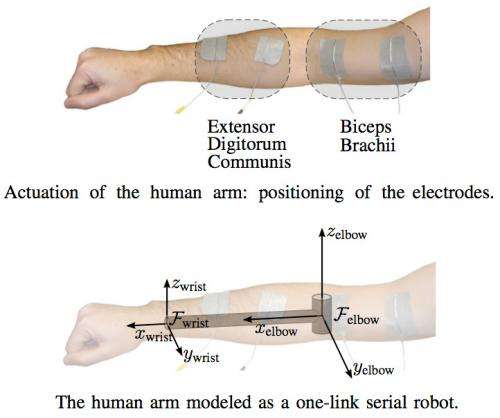November 18, 2011 report
Montpellier team turns tables on robot-human interactions (w/ video)

(PhysOrg.com) -- Robots have entered a newer phase of serving, not obeying. for use in medical settings. Chapter one in robotics history encouraged a perception of clever little machines skating around with the mission to obey a human's commands. Chapter two is upon us where the tables have turned. Robots are being designed to interact with humans who need a helping hand, however mechanical that hand may be.
Scientists have recently come up with a humanoid robot that proves the point. Researchers at French robotics lab LIRMM have created a prototype of a robot that uses electrodes to move a human arm.
The robot has been designed with the functional electrical stimulation (FES) technique of electrical currents in order to activate extremities affected by paralysis resulting from spinal cord injury (SCI), head injury, stroke and other neurological disorders. The robot controls the human limb by sending small electrical currents to electrodes taped to the person's forearm and biceps. This allows it to command the elbow and hand to move.
A demonstration of how this works took place at the recent IEEE International Conference on Intelligent Robots and Systems (IROS),. Observers were most impressed by what they witnessed.
The IEEE Spectrum called it "an experiment that opens a new chapter in human interaction." What the audience saw was a robot and human in collaboration mode.
The person holds a ball, and the robot a hoop; the robot, a small humanoid, has to coordinate the movement of both arms to successfully drop the ball through the hoop.
That is where the demo got interesting; the audience watched as the robot controlled the human, not the other way around. The human’s elbow was made to move to bring the ball closer to the robot’s workspace. The robot moved its hoop after the patient’s arm has been manipulated into the “cooperation zone.”
Electrodes were attached to the arms of five healthy volunteer test subjects, who were blindfolded to avoid visual feedback, so they would not move their arm on their own. One could see how the human hand was made to open and drop the ball
The robot used in the demo is a Fujitsu HOAP-3 humanoid, which is a compact, lightweight robot. The HOAP-3’s arm had four degrees of freedom, to position the hoop right below the ball.
The audience at IROS let out a nervous gasp upon seeing the video, reports the IEEE Spectrum. Bloggers also went to lengths to be funny and entertain the possibility of electrode-armed robots turning to malevolent means to wreak revenge on humans.
Developers of this robot have other scenarios on their mind. Bruno Vilhena Adorno, team spokesperson, notes that the reason these robots are being developed is for medical use. Electric stimulation for such patients has both physical and psychological benefits. The goal is for patients with paralysis and other disabilities to regain use of their motor skills. Adorno calls up a simple scenario of a robot bringing the patient with limited movements a glass of water and then helping the patient to reach and hold the glass.
The work on this robot is by the Montpellier Laboratory of Informatics, Robotics, and Microelectronics (known by its French acronym LIRMM). The effort, in turn, is part of Project Assist. The project goal is to develop a two-arm mobile robot capable of assisting quadriplegic people to manipulate common objects.
The LIRMM robot is in proof of concept stage, for which the team will continue their work. They plan to improve the electrical stimulation. They are now able to move the elbow in both directions. In time they hope to move the arm to any point in space.
More information: Research paper online.
© 2011 PhysOrg.com




















